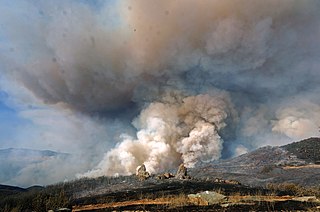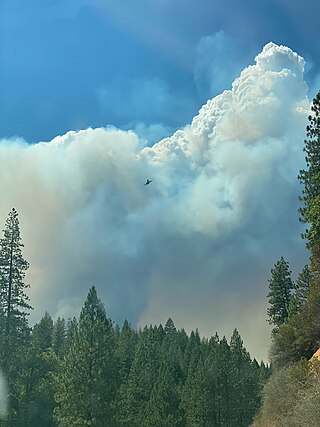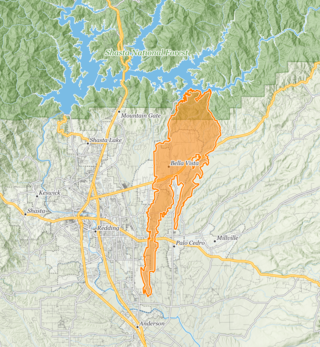
The 2009 California wildfires were a series of 9,159 wildfires that were active in the US state of California, during the year 2009. The fires burned more than 422,147 acres of land from early February through late November, due to Red Flag conditions, destroying hundreds of structures, injuring 134 people, and killing four. The wildfires also caused at least US$134.48 million in damage. Although the fires burned many different regions of California in August, the month was especially notable for several very large fires which burned in Southern California, despite being outside of the normal fire season for that region.

The Clover Fire was a fatal wildfire in Shasta County, California. It burned from September 9 to September 15, 2013 in an area near the communities of Happy Valley and Igo, California, about 10 miles southwest of Redding. It burned more than 8,000 acres (3,200 ha) and caused one death and six injuries. Damages were estimated at $65 million. One man has been charged with arson in the case.
The Wragg Fire was a wildland fire that started just off California State Route 128 near Lake Berryessa in Napa County, California in the United States. The fire started on July 22, 2015. The cause was an idling vehicle's car exhaust. The vehicle came into contact with dry grass and sparked the fire. Mandatory evacuations for 136 homes and 200 residents took place. Six roads were closed temporarily as a result.

The October 2007 California wildfires, also known as the Fall 2007 California firestorm, were a series of about thirty wildfires that began igniting across Southern California on October 20. At least 1,500 homes were destroyed and approximately 972,147 acres of land was burned from Santa Barbara County to the U.S.–Mexico border, surpassing the October 2003 California wildfires in scope, which were estimated to have burned 800,000 acres (3,200 km2). The wildfires killed a total of 14 people, with nine of them dying directly from the fires; 160 others were injured, including at least 124 firefighters. At their height, the raging fires were visible from space. These fires included the vast majority of the largest and deadliest wildfires of the 2007 California wildfire season. The only wildfire in 2007 that surpassed any of the individual October 2007 fires in size was the Zaca Fire.

The Sand Fire was a wildfire in 2016 that burned in the Angeles National Forest, east of the Santa Clarita Valley in Los Angeles County, California. The fire, named for the area's Sand Canyon, was fueled by heavy chaparral and brush.
The Cold Fire was a wildfire that started on August 2, 2016, in the Vaca Mountains, near Lake Berryessa and just west of the city of Winters, in Yolo County, northern California. The fire was contained by 6 PM on August 11 after burning a total of 5,371 acres (21.74 km2), including two buildings, causing an estimated $100,000 in damage.

The Detwiler Fire was a wildfire that burned across Highway 49, east and south of Lake McClure, in Mariposa County, California. Ignited shortly before 4 p.m. on Sunday, July 16, 2017, the fire consumed up to 2,500 acres (1,000 ha) within its first day of burning. By Thursday morning, on July 20, the fire was over 70,000 acres (28,000 ha) in size with only 7 percent containment.

The Carr Fire was a large wildfire that burned in Shasta and Trinity Counties in California, United States. The fire burned 229,651 acres, before it was 100% contained late on August 30, 2018. The Carr Fire destroyed at least 1,604 structures while damaging 277 others, becoming at the time the sixth-most destructive fire in California history, as well as the thirteenth-largest wildfire recorded in modern California history. The Carr Fire cost over $1.659 billion in damages, including $1.5 billion in insured losses and more than $158.7 million in suppression costs. The fire destroyed multiple towns around Whiskeytown Lake. At its height, the fire engaged as many as 4,766 personnel from multiple agencies. The fire was reported on the afternoon of July 23, 2018, at the intersection of Highway 299 and Carr Powerhouse Road, in the Whiskeytown district of the Whiskeytown–Shasta–Trinity National Recreation Area. Coincidental to the name of the incident, the fire was started when a flat tire on a vehicle caused the wheel's rim to scrape against the asphalt, creating sparks that set off the fire.

The Maria Fire was a wildfire that burned the south of the community of Santa Paula in the area of Somis, California on the top of South Mountain in Ventura County. The fire ignited in the evening hours of Thursday, October 31, 2019 and consumed well over 4,000 acres (16 km2) within its first several hours of burning. Despite the aggressive initial attack by first responders, the fire exploded rapidly due to a strong Santa Ana wind event that was occurring in the area during its ignition.
The 2021 Washington wildfire season officially began in March 2021. By late April, all of Eastern Washington had been classified by the United States Drought Monitor as "abnormally dry" with moderate to severe drought conditions. The state had more than 630 wildfires by the first week of July, on par with the state's record 2015 wildfire season.

The Lava Fire was a wildfire that burned 26,409 acres (10,687 ha) along the slopes of Mount Shasta near Weed, California during the 2021 California wildfire season. The fire started on June 25, 2021 and was fully contained on September 3, 2021. The fire destroyed 23 buildings, including 14 houses, as well as damaged an additional building.

The Salt Fire was a wildfire that burned 12,660 acres (5,123 ha) in the Lakehead area north of Shasta Lake in Shasta County, California in the United States during the 2021 California wildfire season. The fire was first reported on Wednesday, June 30, 2021, and it was fully contained on July 19, 2021. The fire destroyed forty-one structures, including twenty-seven residences and fourteen outbuildings, and damaged four additional outbuildings. Although the cause remains under investigation, officials from the Shasta–Trinity National Forest believe that the fire was likely sparked by hot material that fell from a vehicle on Interstate 5 and landed in dry brush next to the freeway.

The 2021 Dixie Fire was an enormous wildfire in Butte, Plumas, Lassen, Shasta, and Tehama counties in Northern California. Named after a nearby Dixie Road, the fire began in the Feather River Canyon near Cresta Dam in Butte County on July 13, 2021, and burned 963,309 acres (389,837 ha) before it was declared 100 percent contained on October 25, 2021. It was the largest single source wildfire in recorded California history, and the second-largest wildfire overall, The fire damaged or destroyed several communities, including Greenville on August 4, Canyondam on August 5, and Warner Valley on August 12.

The McFarland Fire was a wildfire that burned in the Shasta-Trinity National Forest north of Wildwood in Trinity County, Shasta County, and Tehama County, California in the United States. Started by a lightning strike, the fire was first reported on July 29, 2021 on McFarland Ridge south of Highway 36. As of September 16, 2021, the fire had burned 122,653 acres (49,636 ha) and destroyed 46 structures.

The Antelope Fire was a wildfire that burned in the Klamath National Forest, the Modoc National Forest, the Shasta-Trinity National Forest, and in Lava Beds National Monument in Siskiyou County, California, in the United States. The fire was started by a lightning strike and was first reported on August 1, 2021. As of October 15, the fire had burned 145,632 acres (58,935 ha).

The Electra Fire was a wildfire that burned northeast of Mokelumne Hill in Amador and Calaveras Counties, California that started on July 4, 2022. The wildfire burned a total of 4,478 acres (1,812 ha) and was fully contained on July 28, 2022.

The Fawn Fire was a destructive wildfire near in Shasta County, California, in the fall of 2021. Caused by a suspected act of arson in the evening of September 22, the fire began in mountains to the northeast of Redding and was driven by high winds the following day south and west into wildland-urban interface (WUI) neighborhoods. The fire ultimately destroyed 185 structures and damaged 26. Three firefighters engaged in suppression of the fire were injured, but there were no recorded civilian injuries or fatalities. The fire cost more than $25 million to suppress and burned 8,578 acres before being fully contained on October 2. A Palo Alto woman was arrested the day of its ignition and charged with starting the fire. As of 2022, legal proceedings were ongoing.

The Mill Fire was a fast-moving, deadly and destructive wildfire that burned during the 2022 California wildfire season, destroying parts of the communities of Weed, Lake Shastina and Edgewood in Siskiyou County in the U.S. state of California. Igniting during hot, dry & windy conditions on September 2, 2022, amid a record-breaking heat wave that spanned much of the state, the Mill Fire moved rapidly to the north. Most of the fire's acreage burned and structures destroyed occurred on the first day, due to its predominantly wind-driven nature. The Mill Fire burned 3,935 acres, destroyed 118 structures, and damaged 26 more. The fire also caused 2 fatalities when two residents of Weed were unable to escape the quick-moving blaze in its first hours. The fire was fully contained on September 13, 2022.

The 1992 Fountain Fire was a large and destructive wildfire in Shasta County, California. After igniting on August 20 in an act of probable but unattributed arson, the fire was driven by strong winds, outpacing firefighters for two days while exhibiting extreme fire behavior such as long-range spotting, crown fire runs, and pyrocumulonimbus clouds that generated dry lightning. The fire consumed 63,960 acres (25,880 ha) and destroyed hundreds of homes, primarily in the communities of Round Mountain and Montgomery Creek along the State Route 299 corridor. In 1992, the Fountain Fire was the third most destructive wildfire in California's recorded history, though it no longer features among the top 20 most destructive California wildfires. At a suppression cost of more than $22 million, it was then the most expensive fire to contain, but has since been surpassed in that respect.

The 1999 Jones Fire was a destructive wildfire in the U.S. state of California's Shasta County. The fire ignited on October 16, and was contained on October 19, 1999. It burned 26,200 acres (10,600 ha), destroyed 954 structures, and resulted in one fatality, becoming the then-second most destructive wildfire ever recorded in California, behind only the Oakland firestorm of 1991. As of 2023 it remains one of the 20 most destructive wildfires in the history of the state. The cause of the fire was never determined.

















